by Jill Schuman |
July 21, 2017
|
 Pacific Crest Trail, Photo by Bob Wick, BLM.
Pacific Crest Trail, Photo by Bob Wick, BLM.
Ultralight backpackers and thru-hikers are famous (or perhaps infamous) for the seemingly crazy lengths they go to lighten their backpack. If you’re looking to drop a couple pounds from your base weight, try utilizing these four ultralight backpacking tips. (See our story from June for more ideas.)
- Replace your tent stakes
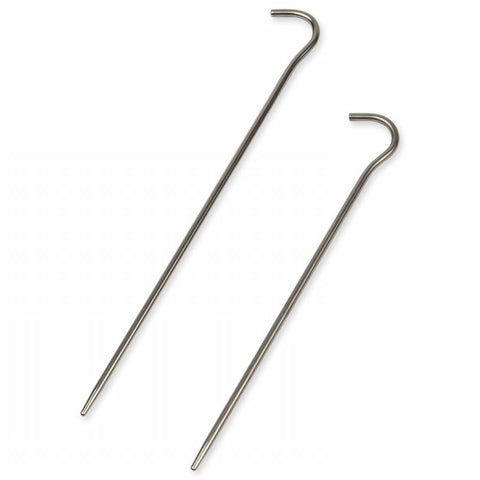
When you’re talking ounces, replacing the tent manufacturer’s stakes with an ultralight version can save you up to two, three, maybe even four ounces. We like Gossamer Gear’s ultralight titanium stakes, which weigh roughly .2oz each. Or, you can go sans stakes and use rocks to stretch out your tent.
- Carry fewer electronics
GPS. Phone. Camera. Portable battery chargers. Solar panels. And then all the cables that go with them. Experience nature with fewer screens. If you have a good smartphone, you can download a GPS app – like GAIA – and use the built-camera. That automatically eliminates two devices in your backpack.
- Make a DIY pillow
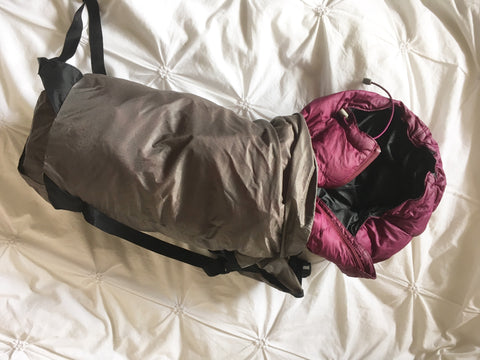
Why carry a pillow (11 oz.) when you can make one yourself when you get to camp? Fill a stuff – like the one you carry your sleeping bag in – with your extra layers: rain gear, insulating jacket, extra pair of socks.
- Pack for the weather
Check the highs and lows, chance for precipitation, or other weather events. If it’s not going to be too cold, there’s no need to pack a winter weight jacket. Are you hiking in the desert with 0% chance of rain? Try swapping out your normal rain gear for an ultralight and compressible water-resistant running smock. Of course, it should go without saying, you should always have your basic layers to keep you warm and dry in case of an emergency.
Tagged:
fastpacking tips,
hiking and backpacking tips,
how to lighten your backpack,
thru-hiking tips,
tips for ultralight backpacking,
ultralight backpacking tips,
ultralighting tips
by Jill Schuman |
July 19, 2017
|
There’s a reason why we love our hometown of Durango, CO so much – there’s so many incredible hiking trails, it’s difficult to choose one! If you’re visiting Southwest Colorado this summer, be sure to check out a few of our favorite hikes.
Highland Mary
 The Highland Mary Trail climbing toward the Continental Divide. Photo by Margaret Hedderman.
The Highland Mary Trail climbing toward the Continental Divide. Photo by Margaret Hedderman.
Named for a nearby mine, the Highland Mary Trail is one of Southwest Colorado’s true gems. Starting at 10,750 ft., the trail quickly climbs above treeline and affords incredible views of the San Juan Mountains almost the entire way. Once you reach the first Highland Mary Lake at 12,310 ft., it’s an easy hike to the nearby Verde Lakes where, believe it or not, the views are even better. Roundtrip, the hike is roughly 6.6 miles. It’s also possible to connect to the Continental Divide Trail and make an 8-mile loop.
Ice Lakes
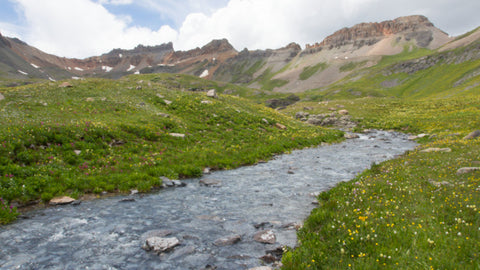 The outlet stream flowing out of Ice Lake near Silverton, CO. Photo by Larry Gross.
The outlet stream flowing out of Ice Lake near Silverton, CO. Photo by Larry Gross.
Another favorite near Silverton is the Ice Lakes Trail. Though its only 3.5 mile to the main lake, it’s a real slog. You’ll climb nearly 2,500 ft. from the trailhead to the lake! Because this trail takes you above tree line, you’ll want to start early to avoid the afternoon thunderstorms. Plus, it’s one of the most popular trails in the region, so you’ll want to beat the crowds. If you fancy additional altitude, hike another mile up the steep rocky ridge above Ice Lake to reach the gorgeous Island Lake.
Indian Trail Ridge
 Indian Trail Ridge near Durango, CO. Photo by Margaret Hedderman
Indian Trail Ridge near Durango, CO. Photo by Margaret Hedderman
You’ll need access to a 4WD vehicle to reach the trailhead as it begins at the top of Kennebec Pass, 11,600 ft. This is one of the Colorado Trail’s most spectacular sections, but it’s completely exposed so you’ll want to keep an eye on the weather. Follow the CT to Taylor Lake (a lovely campsite, if you’d like to stay the night and hike Indian Trail Ridge the following morning). From there, you’ll quickly gain elevation to the top of the ridge. The La Platas are every bit as spectacular as the San Juans and see considerably less traffic. Enjoy the views! Once you’ve gained the ridge, it’s easy to follow north with little elevation gain.
Mountain View Crest
 The hike to Mountain View Crest. Photo by Larry Gross.
The hike to Mountain View Crest. Photo by Larry Gross.
Another trail that requires 4WD, Mountain View Crest is perhaps one of the easiest, yet most rewarding hikes in the Durango area. Follow the Lime Mesa Trail, which begins at 11,800 ft. to the top of Mountain View Crest. Here the mesa suddenly breaks away, revealing views of the Animas River, the Weminuche Wilderness, and numerous 14ers. All in all, the trail gains little elevation (only 700 ft.), so it’s a pleasant way to spend a morning!
Tagged:
best hikes near Durango CO,
Highland Mary Trail Colorado,
hikes near Durango CO,
hiking Durango CO,
Hiking Ice Lakes Trail Colorado,
Hiking Indian Trail Ridge Durango,
Ice Lakes Trail Silverton CO,
Indian Trail Ridge Colorado Trail,
Lime Mesa Trail Durango,
Mountain View Crest Trail Durango
by Jill Schuman |
July 13, 2017
|
Back in February, we wrote about some extra-tasty DIY adventure foods. It was so popular, we decided to find three more easy, fun and healthy adventure meals you can make in your own kitchen. From a homemade protein bar to a super-cheesy casserole, bonking on your next backpacking trip will be the least of your concerns.
Cheesy Chicken with Broccoli & Rice
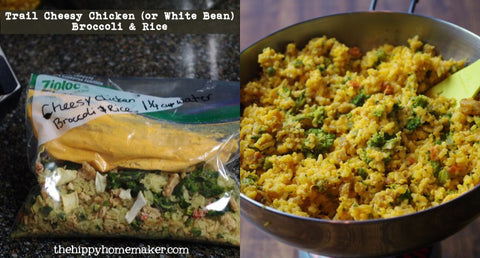
This is a relatively simple backpacking meal from The Hippy Homemaker that you can prep at home before hitting the trail. With lots of cheese and protein, this savory dish will be extra satisfying after a long day in the mountains. You’ll need a dehydrator to make this meal, so we’d recommend doubling it to make a couple meals. Veggies can substitute the chicken for white beans.
No-Bake Protein Bars
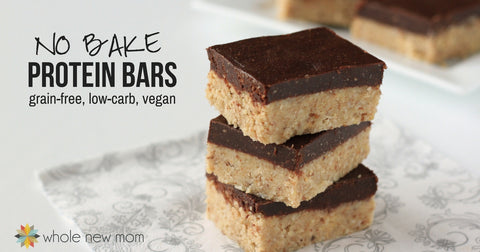
This super healthy DIY protein bar from Whole New Mom is grain-free, using pulverized nuts, coconut oil, and flax meal instead of flour. Plus it’s no-bake, so you won’t have to heat up your kitchen on soft summer days. Hikers, if you’re heading out on long expeditions, try making this with macadamia nuts for extra fat.
Homemade Vegetable Crisps

Last week we talked about the importance of eating salt when you’re exercising in hot weather. Here’s an easy and healthy recipe from Jaime Oliver for homemade vegetable crisps – beets, parsnips, and carrots – with spicy salt. Remember to convert 150ºC to 302ºF. Pack a ziplock bag of these and enjoy in a shady spot with a spectacular view.
Tagged:
backpacking meals,
backpacking recipes,
DIY adventure food,
DIY backpacking meals,
DIY dehydrated backpacking meals,
homemade adventure food,
homemade backpacking meals,
homemade chips,
homemade protein bars
by Jill Schuman |
July 11, 2017
|
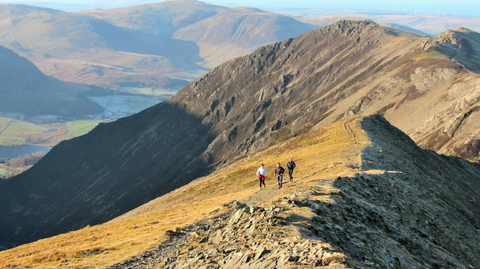
Fellrunners in England's Lake District, photo courtesy of Peer Lawther
Anyone who’s taken a pair of road shoes onto the trail knows the sudden, terrifying moment when you lose traction on a steep, gravelly downhill. There’s a real reason – beyond getting you to buy more shoes – that running companies develop so many different tread patterns for their shoes. From minimal grip to giant lugs, there’s a choice for every type of terrain. Here’s a quick look into the best tread for the job.
Road
The outsoles for a road shoe are specifically designed for hard surfaces such as pavement. You’ll find they have a fairly even, low-profile tread pattern. Just as you wouldn’t want to take a road shoe onto a technical trail, it would be a bad idea to wear a trail shoe on the road for long distances. It would be like using your snow tires year-round – you’ll quickly wear out that specialized tread on the pavement. Plus, many trail shoes have a stiffer flex and would be uncomfortable for long road distances.
Light Trail
We’re talking hard packed tracks – whether in the mountains, desert, or forest. On these harder surfaces, you’ll want to find a tread pattern between a road and an intensely technical trail shoe. If this is your trail du jour, try something like Salomon’s Sense Pros or the Brooks Cascadia. Both of these are aggressive enough to tackle difficult terrain in a pinch, but will provide a certain level of comfort on hard surfaces.
Technical Trail, Mud and Snow
If mud, blood, and snow is your thing, you’ll want to find a trail runner with deep, aggressive lugs. The deeper the tread, the better it will perform in slippery conditions. A soft tread can perform better in thick mud, but will wear out a lot quicker than a harder rubber. Check out Salomon’s Speedcross 4 or the Altra King MT.
Of course, once you start shopping, you’ll find every shoe brand a myriad of tread options. Just keep in mind: The deeper the tread, the more technical the trail.
Tagged:
altra trail running shoes,
brooks trail running shoes,
difference in running shoe treads,
difference in trail running shoes,
salomon trail running shoes,
why you need trail running shoes
by Jill Schuman |
July 06, 2017
|

When the weatherman calls for “another scorcher,” it’s tough to work up the motivation to go outside. Whether you’re a runner, hiker, mountain biker or bird watcher, the summer heat can present a myriad of health and safety challenges. But that’s not to say don’t go outside! Instead, take a few simple precautions and have fun this summer!
Take a cue from the birds
and start your adventure early. Hit the trail while the cool of the night still lingers. You can easily pack in several miles before the heat of the day hits.
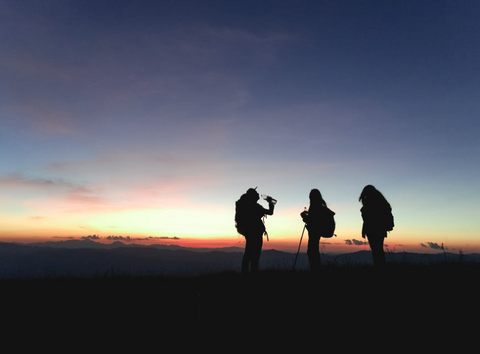
Drink plenty of water
and don’t wait until you’re thirsty to start because by then it’s too late. Most nutritionists say you should drink at least 2L of water per day for normal activity. If you’re outside playing in the sun, you’ll need to drink twice that or more, depending on the temperature, altitude, and your level of exertion. If you’re out for the day, try carrying an ultralight water filter or purifying tablets, so you can refill your water bottles along the way.
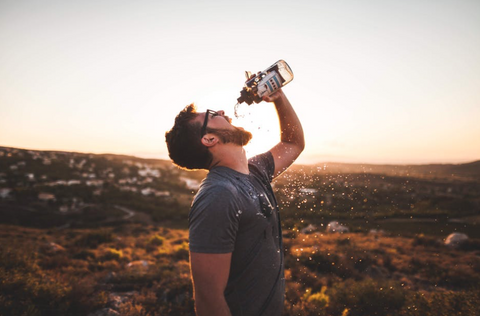
Enjoy some salty snacks
to prevent muscle cramps. When you cramp up after a day on the trail, it’s likely because of sodium loss through extensive sweating. Take a bag of salty chips or energy bars that are high in sodium. You can also mix nutrition powders like Tailwind into your water to help restore electrolytes.

Cover up with lightweight, loose fitting, breathable clothing
and don’t forget a hat! It might sound counterintuitive, but one of the best ways to prevent heat exhaustion is to cover up your skin with long sleeves and pants. (According to Center for Disease Control!) Choose light colors to help repel the heat and quick-drying fabrics to wick the moisture away from your skin.
Know the signs
of dehydration and heat exhaustion. If you’re experiencing extreme thirst, dry mouth, headaches, and dizziness, it’s time to get out of the sun, rest, and drink some water with an electrolyte supplement or mix with a sports drink to replace nutrients. You can read more about that here.
Go for a swim
or exercise indoors if it’s too hot and humid. High humidity + heat can lead to hyperthermia (overheating), heat exhaustion, dehydration, and even fainting. There’s no shame in taking a rain check on that hike and going for a swim instead!

Tagged:
eat salty foods while hiking,
exercising in hot weather,
hiking in hot weather,
hiking in the heat health,
how to avoid dehydration,
replenish electrolytes while exercising in the heat,
signs of dehydration,
tips on exercising in the heat
 Pacific Crest Trail, Photo by Bob Wick, BLM.
Pacific Crest Trail, Photo by Bob Wick, BLM.


 Pacific Crest Trail,
Pacific Crest Trail, 
 The Highland Mary Trail climbing toward the Continental Divide. Photo by Margaret Hedderman.
The Highland Mary Trail climbing toward the Continental Divide. Photo by Margaret Hedderman. The outlet stream flowing out of Ice Lake near Silverton, CO. Photo by Larry Gross.
The outlet stream flowing out of Ice Lake near Silverton, CO. Photo by Larry Gross. Indian Trail Ridge near Durango, CO. Photo by Margaret Hedderman
Indian Trail Ridge near Durango, CO. Photo by Margaret Hedderman The hike to Mountain View Crest. Photo by Larry Gross.
The hike to Mountain View Crest. Photo by Larry Gross. 



 A look at a classic road tread from ASICS GT-2000 5 Road-Running Shoes
A look at a classic road tread from ASICS GT-2000 5 Road-Running Shoes
 Altra King MT Trail Running Shoes Tread
Altra King MT Trail Running Shoes Tread



